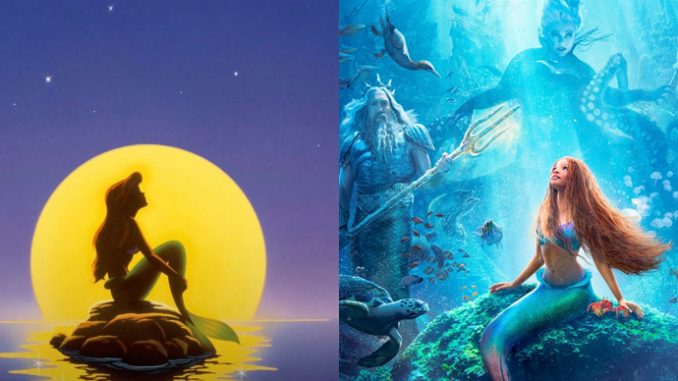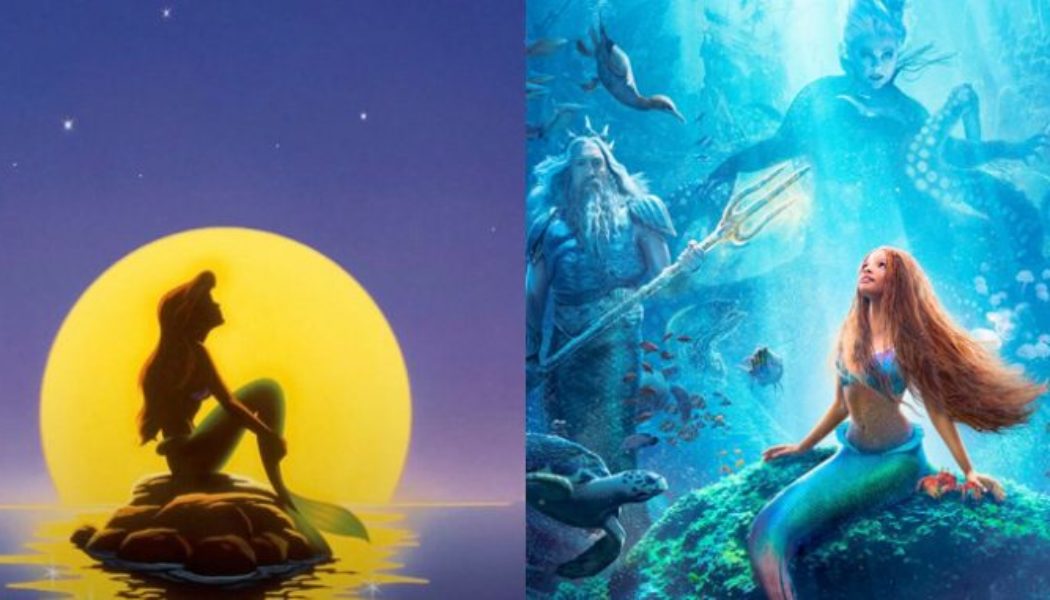
There’s something profoundly melancholy about Disney returning, in its present state of creative exhaustion and corporate decadence, to The Little Mermaid—the nucleus from which the entire Disney renaissance exploded, in a way along with everything that has followed.
The last time Disney was artistically lost to the degree that it is now was in the doldrums of the 1980s, when it was reduced to feeble, forgettable fare like The Black Cauldron and Oliver & Company. Amid this dreary landscape, the arrival of The Little Mermaid in November 1989 came like a bolt from the blue (from King Triton’s trident of power, as it were).
The return to fairytale romance and the appeal of the mermaid archetype gives The Little Mermaid an ambitious mythic scope that hadn’t been seen since Sleeping Beauty 30 years earlier. Ariel, with her fascination for artifacts of the surface world, is a more vividly drawn protagonist than any prior Disney princess, and almost any prior Disney heroine. Ursula the Sea-Witch’s decadent look (famously inspired by drag queen Divine) and larger-than-life performance by Pat Carroll, her husky voice dripping with self-amused irony, put her on a villainous par with Sleeping Beauty’s Maleficent. The plot, adapted from Hans Christian Andersen’s fairy tale with typically sweeping license and an obligatory happy ending blithely grafted on in place of Andersen’s high-minded, tragic one, is lumpy but memorable.
Most important is the film’s secret weapon, the thing that blew up the old way of making Disney cartoons: the brilliance of songwriting team Howard Ashman and Alan Menken and the showstopping Broadway energy of the sequences the animators crafted for their songs. Ariel’s iconic “I Want” song “Part of Your World,” yearningly performed by Jodi Benson, resonates deeply in part because of how Ashman works Ariel’s passion for the human world into a metaphor for adolescent longing for independence and achievement. The Caribbean rhythms and catchy melodies of “Under the Sea” and “Kiss the Girl,” with the colorful razzle-dazzle of the former and the swoony, moonlit magic of the latter, remain high-water marks in American animated musical production numbers. (I remember standing up and cheering in the theater after “Under the Sea”; I was an art-school student and a serious animation fan.) Ursula’s Villain song, “Poor Unfortunate Souls,” is both a deliciously droll celebration of the Sea-Witch’s stylish depravity and also an insinuating sales pitch to the vulnerable, naïve Ariel. And don’t forget René Auberjonois’ unhinged, Clousseau-accented narration of the wacky slapstick of “Les Poissons”!
Among supporting players, Flounder the fish and Scuttle the seagull are pretty typical—but Sebastian the crab is perhaps the most engaging Disney sidekick since the days of Timothy Q. Mouse and Jiminy Cricket (not that the competition is fierce). This is partly, of course, because of his key role in two of the musical highlights, but also because of Samuel E. Wright’s performance. Sebastian’s name and position as court composer evoke the world of Western classical music, and he could easily have been a submarine counterpart to, say, The Sword in the Stone’s Archimedes the owl: a generically fusty, British stereotype with a piping voice like so many diminutive Disney sidekicks (indeed, look no further than King Triton’s seahorse herald). Instead, Wright’s melodious baritone, and his unexpected Trini accent (Ashman originally suggested a Jamaican accent, but Wright was more comfortable modeling his performance on college roommates from Trinidad), give Sebastian a unique vibe well suited to the movie’s marine milieu.
While less creativity went into Prince Eric and King Triton, Christopher Daniel Barnes is adequately appealing as Eric, and Kenneth Mars provides the template for domineering Disney dads for years to come. The potent father-daughter conflict isn’t completely without precedent—see, for example, Peter Pan’s blustering Father Darling capriciously exiling Wendy from the nursery, only to relent at the end—but Ariel’s emotional volatility and teenaged willfulness make for more compelling drama than Wendy’s meek biddability. (Ariel’s temperament led to the choice to make her a redhead, adding to her distinctiveness.) The influence of the Junior Knows Best trope has been even more enduring than the Ashman/Menken musical revolution, as has the substantial theme of conflict around prejudice and openness regarding another culture.
Reimagining Andersen
The first two-thirds of Ariel’s story at least loosely reflect the events of the anonymous mermaid of Andersen’s tale, though without Andersen’s framework of overtly religious ideas. The youngest daughter of the widowed Sea-King, our heroine is fascinated by the surface world, and falls in love with a handsome prince whom she rescues from drowning after a storm sinks his ship. Yearning to visit him, she strikes a bargain with the sinister Sea-Witch, who, in exchange for her beautiful voice, gives her a potion that grants her legs. If the prince falls in love with her, the Sea-Witch says, all will be well; if not, there is a terrible price to pay. (In Andersen, the prince must marry her; if he marries someone else, the mermaid will turn into sea foam, and, because merfolk have no immortal souls, cease to exist. In the Disney version, he must kiss her with the kiss of true love—within three days!—or she will become a worm-like polyp in the Sea-Witch’s garden.) Then a romantic rival appears whom the prince wrongly credits with rescuing him from drowning, and a royal wedding is announced at once. (In the Disney version the rival is Ursula in disguise, using Ariel’s voice to bewitch the prince.)
In Andersen’s account, the prince does marry the rival, and the mermaid, resisting another offer from the Sea-Witch to recover her mermaid form by murdering the prince in his sleep, does turn into sea foam—but, instead of ceasing to exist, she is rewarded for her suffering and good deeds by becoming an air-spirit with the hope of one day achieving immortality and salvation. Obviously none of this would do for a Disney musical, but what happens instead is, for me, the cartoon’s biggest, ah, sticking point.
Ursula’s machinations manage to delay true love’s kiss just long enough for Ariel to fall into her power. Triton tries to rescue his daughter, but all his power is useless against the unbreakable magic of Ariel’s contract with Ursula. To free Ariel, Triton surrenders to the Sea-Witch’s power, becoming one of her garden polyps and effectively yielding his trident of power to Ursula, now the supremely powerful Sea-Queen—a very bad bargain for the greater good!
At this point, having effectively written themselves into a corner, the writers turn to a startlingly arbitrary conceit. Pushed by Disney chairman Jeffrey Katzenberg to make the ending “more Die Hard,” writer/directors John Musker and Ron Clements wound up having Ursula use the power of the trident to grow to approximately the size of the Nakatomi Tower. She then begins stirring up the ocean into a maelstrom, ostensibly to expose Ariel and Eric in order to kill them. The whirlpool raises wrecked ship hulls from the ocean floor, one of which Eric manages to commandeer, and, by steering hard amidst the vortex, skewers the titanic Sea-Witch with the splintered bowsprit, killing her. Upon Ursula’s death, her polyps are restored to merfolk form, including Triton, who recovers his trident and crown. Triton then uses his power to restore Ariel’s legs so that she can marry Eric with his blessing.
The inescapable problem with Ursula’s downfall is that the drama in The Little Mermaid has been rule-driven; it has turned on agreements, contracts, loopholes, and even cheating, but cheating to achieve or to avoid rule-defined states. To get legs, Ariel must surrender her voice; if Prince Eric kisses Ariel within three days, Ariel lives happily ever after: a rule binding even on Ursula, so that she first staves off defeat by upsetting Eric’s rowboat moments before he would have kissed her, and then transforms herself into a beautiful woman, hypnotizing Eric with Ariel’s voice. Ariel and Ursula’s contract is so unbreakable that Triton can free his daughter only by striking another bargain: by surrendering himself into the Sea-Witch’s power.
A story like this demands a rule-driven resolution. Somehow Ursula must be defeated by some loophole she didn’t see coming or forced to strike a new bargain. Die Hard–esque brute force is as unsatisfying here as it would be if Die Hard ended like Raiders of the Lost Ark, with God showing up and killing all the bad guys. It’s not deus ex machina in Raiders because that’s what Raiders is about—but it would be in Die Hard, and Die Hard solutions are just as out of place in The Little Mermaid. (Both Beauty and the Beast and Aladdin do better in this regard; particularly notable is how Aladdin defeats Jafar, not by exploiting the Genie’s power, but, in keeping with the movie’s moral theme, by being himself and relying on his wits.)
Mermaid redux
Kenneth Branagh’s wholesome, charming Cinderella was both the best thing and the worst thing to happen in the modern era of Disney live-action nostalgia. It was a good thing because its critical and popular success made it a compelling case for sincerity and goodness at a time of cynical, subversive reimaginings like Maleficent (which pointedly subverts Sleeping Beauty’s Christian symbolism) and Tim Burton’s Alice in Wonderland. Cinderella’s success paved the way for the serial-adventure thrills of Jon Favreau’s The Jungle Book and the contemplative soulfulness of David Lowery’s Pete’s Dragon. But it was a bad thing because the kind of creative liberties that allowed those three films to succeed was unthinkable when it came to remaking the sacred texts of the Disney renaissance: Beauty and the Beast, Aladdin, The Lion King, Mulan, and now The Little Mermaid, from director Rob Marshall and screenwriter David Magee (who previously collaborated on Mary Poppins Returns).
It didn’t have to be this way. Both Cinderella and The Jungle Book went back to literary sources to deepen and enrich their narratives. For example, such Kiplingesque devices as the Water Truce and the Peace Rock, the Law for the Wolves, and the elephant creation-myth, all omitted from the 1967 hand-drawn Jungle Book, are included in Favreau’s version. The new The Little Mermaid feints in this direction in its opening minutes. First comes a poignant epigraph drawn from Andersen: But a mermaid has no tears, and therefore she suffers so much more. In the first scene a sailor on Prince Eric’s ship talks about mermaids luring men to their deaths. (Andersen actually rejects this idea, though he says the little mermaid has the most beautiful voice in the world. Still, it’s drawn from mermaid lore and could be interesting, given the mutual animus between humans and mermaids in this version.) Intriguingly, Ursula (Melissa McCarthy) calls Ariel’s singing voice a “siren song” and, mysteriously, credits Ariel (Halle Bailey) singing to Prince Eric (Jonah Hauer-King) on the beach after rescuing him with “saving” him. Oh, and following Andersen, Ursula’s polyps are no longer enslaved merfolk, but guardians of her home.
Alas. Nothing comes of any of this. Marshall and Magee have no more interest in mermaid suffering than the 1989 cartoon, which is fair enough, but what’s the point of the epigraph? The alleged siren qualities of this Ariel’s voice aren’t explored further one way or another (Ursula still uses Ariel’s voice to enchant Eric, but no new light is shed on how this works). The same goes for some character back-story ideas with potential interest, like making Ursula the resentful sister of King Triton, giving Triton a grudge against humans for killing Ariel’s mother, and giving Prince Eric a living adoptive mother. There are thematic stabs at multiculturalism and environmentalism. Prince Eric wants to be a different kind of leader, not “trapped in his castle,” but traveling and learning from other cultures to keep his own kingdom from “being left behind.” Meanwhile, Triton rails against humans—“the most dangerous species of all”—for despoiling the oceans, and Eric worries about his island kingdom slowly succumbing to the oceans rising at Triton’s wrath. Except for a cute sequence in which Eric and Ariel bond over maps and curios Eric has collected in his travels, none of these ideas add anything notable.
So far from expanding the mermaid mythology, in some ways the remake weirdly atrophies King Triton’s kingdom. In the cartoon Triton held court in an imposing undersea castle where vast throngs of merfolk converged for royal events and Triton rode in a chariot-shell pulled by dolphins. When Ariel vanishes, Triton anxiously commands that no one in his kingdom should sleep until she is found. In the 2023 film, there’s no castle, no royal events, and, until the very end, no merfolk at all other than Triton and his daughters, who don’t live with him, but in the seven seas. While it’s true that a photorealistic chariot-shell might look silly, the absence of any castle, court, or other royal trappings, not to mention subjects to be seen, leaves Triton’s crown and trident looking rather odd. Who’s he trying to impress? What exactly is Ursula sore about being cut out of? (In this version, Triton’s daughters assemble from the seven seas for an event called a “coral moon” to report to their father on conditions around the world. They’re a range of different skin tones and ethnicities, raising an awkward question whether merfolk are monogamous or whether Ariel’s sisters have other mothers from the world’s other seas.) When Triton insists that the search for Ariel go on, he’s apparently speaking only to his six older daughters. What kind of all-out search is that?
Restaging a musical
If there’s a reason to see this new Little Mermaid, that reason is Halle Bailey’s Ariel. Possibly not since little Georgie Henley stepped through the wardrobe door into the snowy wood of Narnia has a young actress’s dewy-eyed wonder done so much heavy lifting on behalf of a fantasy premise. Bailey commits to the role so utterly that even when nothing around her is working, I always believe her; for me she is Ariel. Just as crucially, Bailey is an expressive and powerful singer. Her rendition of “Part of Your World”—closely following Benson’s in the original with a just few personal touches, notably a flourish of melisma near the end—is perhaps the one element of the new film that equals the original, aurally at least. Perhaps Marshall’s best creative choice was having Bailey sing backup vocals on “Under the Sea,” as if Ariel were swayed by Sebastian’s pitch on behalf of the marine world. Turning it into an actual duet between Sebastian and Ariel might have been even better (and would have added to the impact of Ariel’s disappearance at the end).
“Under the Sea” is also the one sequence that just about matches the spectacular visual appeal of the original. In this one standout set piece, a riot of vibrant iridescence and rhythmic movement brings the undersea world to stylish, stylized life, rippling sea slugs, bioluminescent jellyfish, cartwheeling feather stars and other species cavorting with no concession to realism. While I didn’t stand up and cheer, I did think that this is what Tim Burton, remaking Dumbo, should have been aiming at instead of settling for the glaringly non-surreal imagery of his “Pink Elephants on Parade.” (Less favorably, Sebastian singing “Down here all the fish is happy” while we are incongruously looking at dolphins reminded me of a similarly sloppy juxtaposition in the Aladdin remake, with ostriches onscreen while Will Smith’s Genie sings about “exotic-type mammals.” Are these blunders in direction, choreography, editing, or zoology?)
Other musical sequences, including, alas, “Part of Your World,” are less successfully visualized. Often they suffer, like much of the film, from the murky, underlit look of many Disney tentpoles these days. In the underwater sequences, as in the aquatic Namor sequences of Black Panther: Wakanda Forever, the dimness ostensibly approximates realism, but the real function is to camouflage CGI quality issues. (For a far better approach to underwater visuals, see DC’s Aquaman, not to mention Avatar: The Way of Water.) In fact, underlit visuals also mar much of the surface-world shooting, though not all. Too much of The Little Mermaid fails at a basic level: It’s not worth looking at.
Although I can’t refute Marshall’s contention that “Les Poissons” is too goofy to work in live action, I still resent its omission. Less explicable is the dearth of supporting voices in Sebastian’s two big musical numbers. I’m glad that Ariel sings backup on “Under the Sea,” but where’s the deep-voiced fish singing “Guess who’s gon’ be on the plate?” Why are we stuck with just Flounder (Jacob Tremblay) and Scuttle (Awkwafina) singing backup for “Kiss the Girl”?
Prince Eric gets an “I Want” song of his own, “Wild Uncharted Waters,” with music by Alan Menken and lyrics by Lin-Manuel Miranda, layered with Ariel’s wordless theme. Hauer-King has pipes and Miranda has bars, so what’s missing? Why is the song generic and unmemorable? Lack of humor is part of it, I think. Certainly there’s humor in Scuttle’s new song, “Scuttlebutt,” a rap interlude I imagine many will find annoying, though that seems to me a feature rather than a bug.
Miranda also tweaks a few lyrics, ostensibly for modern sensibilities, though if anything the changes only highlight any possible disconnect. I don’t see how the “Kiss the Girl” line “Possible she want you too, there is one way to ask her” raises real concerns around Eric forcing himself on Ariel—but certainly having Diggs’ Sebastian sing instead “Use your words, boy, and ask her” serves only to make us aware that Eric leans in to kiss Ariel without “using his words.” Likewise, the notable absence of Ursula’s patter about how human men aren’t into chatty women (“The men up there don’t like a lot of blabber…Yes, on land, it’s much preferred for ladies not to say a word”) doesn’t change the fact that it’s still a story about a young woman who gives up her voice to be with the man of her dreams.
Parting thoughts
Best supporting players are Daveed Diggs as Sebastian and Melissa McCarthy as Ursula. Neither can match the vocal richness of the original performers—a recurring pattern in Disney remake voice casting—but both are talented enough to make the roles their own. As always, the more exactly the dialogue mirrors the original screenplay, the more often the new line readings fall short; we would miss Wright less if Diggs weren’t asked to say lines like “Somebody ought to nail that girl’s fins to the floor” or “You are hopeless, child…completely hopeless.”
Awkwafina’s goofiness is much better suited to Scuttle than to her draconian role in Raya and the Last Dragon. (Scuttle is now a gannet instead of a seagull, a good move that allows her to converse with Ariel underwater, heightening the taboo of the surface world.) Noma Dumezweni is fine in a rather thankless new part as Queen Selina, Eric’s adopted mother. Bardem’s Triton is a weak link, stiff and grim, without the undercurrent of humor and affection for Ariel that I suddenly appreciate anew in the hand-drawn Triton. (Nothing so readily highlights a movie’s inconspicuous strengths as the flaws of another movie.)
Sometimes you can feel the filmmakers scrambling to address perceived plot holes or other problems. There are no longer any written contracts with the Sea-Witch, because if Ariel can read and write, why wouldn’t she just explain to Eric in writing who she is? Ursula also secretly causes Ariel to forget that she needs Eric to kiss her—ostensibly for her own purposes, although the real reason, I guess, is to remove any question of coercion in the “Kiss the Girl” sequence. No detail is too small: Would Ariel really be completely mystified by the discovery of a fork in the shipwreck? Now she calls it “the smallest trident I’ve ever seen.”
The low point of the remake, for me, might be the Die Hard climax, precisely because it’s clear that the filmmakers want to empower Ariel but have no new ideas about doing that or defeating Ursula. What if the key to defeating Ursula was not a shipwreck, but Ariel’s voice—her “siren song”? What if the real reason Ursula wanted Ariel’s voice is that she knew it could somehow empower Ariel to defeat her?
This would require rethinking the rules of the story—but then only such a rethinking could make revisiting the story really worthwhile. The hand-drawn Little Mermaid is not a perfect film, but it is, I think, the best possible version of itself. I can imagine a better Little Mermaid movie, but it would have to be a real outside-the-box reimagining, made with the kind of creative daring that sparked the Disney renaissance in the first place. It would take filmmakers who are eager to explore, like Prince Eric, and not get left behind. The Little Mermaid is the product of a studio machine that’s content to remain trapped in its castle.
If you value the news and views Catholic World Report provides, please consider donating to support our efforts. Your contribution will help us continue to make CWR available to all readers worldwide for free, without a subscription. Thank you for your generosity!
Click here for more information on donating to CWR. Click here to sign up for our newsletter.






